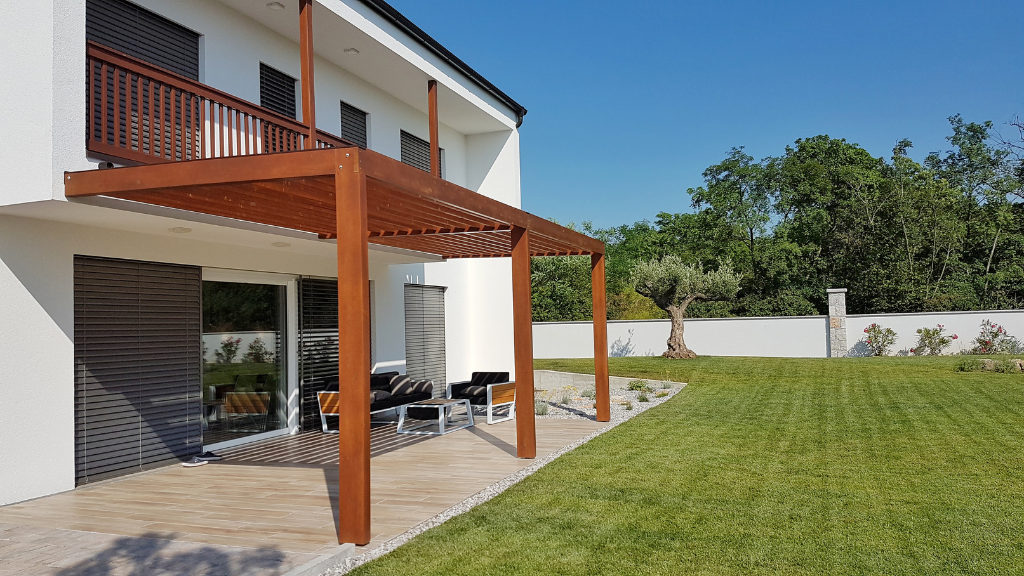Adding a pergola to your outdoor space can transform it into a serene haven, providing shade and style. However, choosing suitable material is the key to a successful pergola installation.
In this article, we’ll delve into the standard pergola material options so you can make an informed decision that enhances your outdoor space’s beauty and longevity.
Wood: Timeless Elegance and Warmth
There’s something undeniably charming about a wooden pergola. Materials like cedar, redwood, and pressure-treated lumber are popular materials due to their natural beauty and durability.
Wood exudes a warmth that complements various landscapes and architectural styles. Remember, though, that wood requires regular maintenance to prevent rot and decay. Investing time in sealing, staining, and occasional sanding can significantly extend the life of your wooden pergola.
Vinyl: Durability in Every Hue
For those seeking low-maintenance beauty, vinyl is an excellent option. Vinyl pergolas are known for their weather-resistant properties, making them impervious to rain, snow, and pests.
Available in various colors and finishes, vinyl can effortlessly match your design vision. The best part? Minimal upkeep is required—no need for staining or repainting. Just a simple wash from time to time will keep your vinyl pergola looking pristine.
Aluminum: Modern Simplicity
If a modern and sleek aesthetic appeals to you, consider an aluminum pergola. This lightweight material offers rust resistance, making it perfect for humid climates.
It’s clean lines and minimalistic design can lend a contemporary touch to any outdoor space. Plus, maintenance is a breeze—a periodic cleaning will maintain its shine and appeal.
Fiberglass: Versatility and Durability
Fiberglass is an intriguing choice for those who desire intricate designs and high durability.
Resistant to rot, insects, and fading, fiberglass pergolas offer a longer lifespan. Its versatility allows for various design possibilities, making them suitable for even the most creative of visions.
Making the Decision: Considerations and Tips
Several factors should be taken into account when selecting the right pergola material. This is to ensure that your choice aligns with your outdoor space’s beauty, functionality, and longevity.
A. Climate and Weather Resistance
The climate in your region plays a pivotal role in determining the ideal material for your pergola. Different materials react differently to varying weather conditions, such as rain, snow, and intense sunlight.
For instance, if you reside in an area prone to heavy rainfall, selecting a material naturally resistant to water damage is crucial to prevent rot and deterioration.
In regions with harsh winters and frequent snowfall, materials that can endure the weight of snow without warping or collapsing are highly recommended. Similarly, if your location experiences scorching sunlight, opting for a material that can resist fading and UV damage will help maintain your pergola’s aesthetic appeal over time.
B. Maintenance and Longevity
The level of maintenance required for your chosen pergola material directly impacts its longevity and your overall enjoyment of the outdoor structure. Low-maintenance materials can save you both time and money in the long run.
For example, vinyl, aluminum, and fiberglass are known for their minimal upkeep requirements. Regular cleaning and occasional inspections are sufficient to keep them looking their best.
Comparatively, wood materials may demand more attention due to their susceptibility to decay, insects, and weathering. While wood exudes a timeless charm, it does necessitate periodic staining, sealing, and potential repairs to ensure its durability. When selecting a material, consider how much time and effort you will invest in maintenance.
C. Aesthetic Appeal
The visual impact of your pergola is a significant consideration. Different materials contribute distinct aesthetics that harmonize or contrast with your existing architectural style and outdoor landscape.
Wood, for instance, offers a warm and inviting feel, often enhancing a rustic or traditional setting. On the other hand, sleek materials like aluminum and fiberglass can complement modern architectural styles, adding a touch of contemporary elegance to your outdoor spaces.
Choosing a material that resonates with your design vision and contributes to the overall atmosphere you wish to create is essential. Remember that the pergola should seamlessly blend with your outdoor environment, enhancing its beauty rather than overwhelming it.
D. Budget
Budget is another vital factor when choosing a pergola material. Different materials come with varying price points, impacting initial and long-term costs.
While wood and certain metals might have lower upfront costs, remember that they could demand more maintenance over time, which can add up. Higher-quality, durable materials like vinyl, aluminum, and fiberglass may have higher initial costs but require fewer ongoing expenditures.
Final thoughts
In the end, the choice of pergola material is a personal one that involves considering various factors, from climate and maintenance to aesthetics and budget.
By taking the time to weigh these considerations carefully, you can ensure that your pergola will stand firm and enhance your outdoor space’s beauty and functionality for years to come. Happy pergola hunting!

